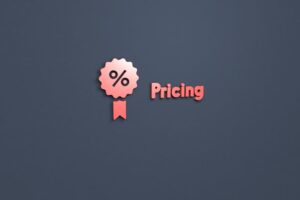Value-based pricing is a pricing strategy that bases prices primarily on consumers’ perceived value of a product or service. The pricing method is used by businesses to determine the price of a product based on how much they believe it is worth to their consumers.
Instead of production or competitor prices, value-based pricing focuses on the customer’s perceived value of a product or service.
Businesses have realized in recent years that traditional pricing models are insufficient to capture the true value of their products and services. As a result, value-based pricing has grown in popularity.
How Does Value-Based Pricing Work?
Value-based pricing is most prevalent in industries where customers’ lives are improved, or users are given access to unique opportunities because they purchase a particular product.
Accordingly, this perceived value indicates the worth customers are ready to attach to an object and determines the price they eventually pay for the product or service.
Consider an auction where multiple buyers compete aggressively, and the highest bidder emerges triumphant. This illustrates the idea of how value-based pricing works.
When setting a product’s price, the consumer, not the supplier, has the final say. Unsurprisingly, 40% of SaaS companies price based on their product’s perceived value.
Value-based pricing does not occur due to the high cost of the materials used to create a product; consumers simply value the finished products and associated experiences. This pricing strategy focuses solely on your product’s benefits to the consumer.

Why Are Businesses Choosing Value-Based Pricing?
As consumers become more interested in how a product can benefit them rather than just its functionalities, businesses are shifting their pricing strategies to focus more on the value of their products or services. For instance, Apple will release new iPhone 15 models in September 2023.
Apple’s business strategy is heavily reliant on the fact that its products stand out from the crowd due to their sleek design. Every new release is an improved version of the one before it. This increases its value to customers ready to pay high for a good product experience.
Consequently, Apple’s OS controls 39% of the US market share for smartphone operating systems.
Value-based pricing thrives because consumers are becoming more selective, and products are becoming more unique in the market.
MORE: How does price skimming work?
Types of Value-based Pricing
Good value pricing
Good value pricing focuses on the quality and service provided to customers rather than the cost of manufacture.
The product’s price is determined by the perceived value of the product and the service provided to customers. It can be accomplished by offering a lower price than competitors or providing extra features or services that justify the additional cost.
For instance, a five-star hotel would cost more than a two-star hotel since it offers more facilities and higher-quality services.
Value-added pricing
Value-added pricing is a pricing approach that considers the extra value a service or product supplies to customers.
The cheapest monthly plan from Bluehost costs just $2.95. However, the fee increases to $5.45 if you want the added privacy and security features for your website.
Value-added pricing is decided by the perceived value of the additional features or services offered to clients. This added value can be improved quality, better customer service, or other perks that rivals can not provide.
Industries That Utilize Value-Based Pricing
Software as a Service (SaaS)
Software as a Service (SaaS) companies typically operate using value-based pricing. For instance, a software provider can charge extra for premium features of greater value, like advanced analytics or software integrations. Recruitee is an example of a software system that uses this pricing strategy.
Recruitee is an HR software tool. With the solution, you can streamline recruiting processes, improve your business’s hiring efficiency, candidate experience, and more. However, users can personalize and change the price plan to meet their specific requirements using the custom pricing method.
If users select a specific feature or part of the service, they can discuss price options that work for them. As such, they are associated with the brand because of the value they will get.
Consulting Services
Consulting firms use a pricing structure based on the value of their services. When a consulting firm helps a company increase its revenue by $1 million, it might charge a percentage of the revenue as its fee. Consumers will be willing to pay these prices because they believe it is worth the value they receive in return.
According to the TigBrand consulting firm CEO;
“The most important thing is to avoid exchanging time for money.” Concentrate on value and connect it to the desired outcome. You never want to be considered a cost, but rather an investment.”
Luxury Goods
Louis Vuitton implements value-based pricing. The product’s value is solely determined by the established image of the logo in people’s minds.
Most luxury brands charge high prices, not usually because their products are very expensive to produce but because their consumers perceive them as high value and are willing to pay high.
Pharmaceuticals
Numerous pharmaceutical companies adopt value-based pricing, especially for life-saving medications. Generic drugs are significantly less expensive than prescription drugs in pharmacies worldwide.
Because these prescription drugs are of high value because of their functionality, patients and insurance companies are usually willing to pay high prices.
Value-Based Pricing vs. Competitor-Based Pricing
| Pricing Strategy | Definition | Advantages | Disadvantages |
|---|---|---|---|
| Competitor-Based Pricing | Prices are set based on what competitors charge. | 1. Prevents pricing yourself out of the market. 2. Avoids starting a price war. | May dilute the unique value of your product. |
| Value-Based Pricing | Prices are set based on the product’s worth to the customer. | 1. More fair and customer-oriented. 2. Potential to make more money while keeping customers satisfied. | Could risk pricing too high or low based on subjective perceived worth. |
How To Calculate Value-Based Pricing
Value-based pricing is more complex than other pricing strategies because it necessitates a thorough understanding of consumer perception.
Here’s a step-by-step guide to calculate value-based pricing:
Step 1: Market and Consumer Segmentation
Before establishing value-based prices, you must thoroughly understand your target market and its various customer segments.
Identify customer segments with distinct needs, preferences, and purchasing propensities. By segmenting your market, you can tailor your value propositions and pricing strategies to each market segment.
MORE: Top Ways for Using AI in Marketing Worldwide.
Step 2: Understand Your Customer’s Needs
After identifying customer segments, you must comprehensively understand their needs and preferences. This usually requires market research, the analysis of consumer data, and direct customer interaction.
MORE: Psychological pricing explained.
Step 3: Determine Your Product’s Value Proposition
A product’s value proposition is the unique combination of features, benefits, and experiences it provides to customers.
To develop a compelling value proposition, consider the following:
- How does your product address needs or problems?
- What characteristics of your product distinguish it from the competition?
- What value does your product add to your customers’ lives?
To effectively communicate your product’s advantages and unique features, ensure to develop a compelling value proposition.
Step 4: Determine the Monetary Value
After figuring out your product’s value proposition, the next step is to measure that value. This can be hard because you must figure out how to put intangible benefits into monetary terms.
You can consider some of the following to measure your value:
- Customer surveys to determine their spending propensity,
- Analyzing the financial impact of your product on your customers’ businesses or personal lives,
- Calculating the value of the time, effort, or resources your product saves.
Step 5: Establish Pricing
After determining your product’s monetary value, the next step is to set your prices with a clear understanding of your product’s value and your customer’s willingness to pay.
Remember that your prices must reflect how your customers perceive the value of your product. One of the ways to balance this across market segments is by implementing tiered pricing or bundling strategies to accommodate their willingness to pay.
Step 6: Continuously Monitor and Refine Your Pricing Strategy
Pricing based on value is not a one-time activity but an ongoing process requiring constant monitoring and modification.
Maintain the effectiveness of your pricing strategy by analyzing sales data, consumer feedback, and market trends regularly.
Be willing to adjust your prices and value proposition as needed to maintain your competitive edge and provide value to your customers.
Examples of Value-Based Pricing
Swiffer Pads
Branded products that include extras or interchangeable parts are another instance where value-based pricing could be implemented.
When purchasing a Swiffer Sweeper, you receive a starter pack of sweeping pads. However, when those are gone, you must decide whether to buy more Swiffer brand pads or seek alternatives.
The issue is that you can’t use pads from competing brands on your Swiffer Sweeper. This is where value-based pricing comes in.
Since you can’t buy stock refills for your Swiffer pads, you must buy them from the same store where you purchased the originals. In turn, you put a higher value on the Swiffer add-on pads that keep your sweeper running.
Diamonds
Diamonds have always been thought to be extremely rare and expensive. Although more and more people are aware of their worth and that they’re actually more popular than implied, the perceived value has not changed.
It’s no wonder the global diamond market is worth $89.18 billion and is expected to grow at a 3.0% annual rate between 2020 and 2030.
This is because people have come to associate gems with high prices. Some even regard it as a symbol of love and commitment, making it appear even more valuable.
The Pros of Value-Based Pricing
- Increased Profit Margins: Value-based pricing can considerably enhance your earnings if your customers are prepared to pay more.
- Increased Brand Value: By focusing more on the value your customer receives, your business ensures that your customers are satisfied, establishing your brand as valuable.
- Customer Loyalty: When you use value-based pricing, you prioritize the consumer’s needs and preferences, which enables you to develop novel methods for improving your products.
The Cons of Value-Based Pricing
- Competitions Undercutting Prices.
- Beneficial for Only Niche Markets.
Is Value Pricing Right For My Business?
You can decide if value-based pricing is proper for you by weighing the pros and cons of your market.
Value-based strategy is typically helpful because it considers what customers want and need. Instead of competing on price, you can focus on creating and communicating exceptional value, justifying higher prices for your products.
However, success with this strategy necessitates a thorough understanding of consumer perceptions, willingness to pay, and competitor strategies. Additionally, it is essential to convey your product’s added value effectively.
Despite the effort required, value-based pricing is an effective pricing model that can result in benefits. This Pricing strategy could be a game changer for your business if you can consistently deliver, maintain, and demonstrate exceptional value.
MORE: Charm pricing strategy explained.
Takeaway Points
Price is the true leverage for the scalability of sales and profits. Creating a price plan allows businesses to optimize revenue and market demand, among other things.
When determining prices using a value-based pricing strategy, the focus is on the customer’s perceived or anticipated value of the product or service.
Although the strategy frequently results in greater profits, it necessitates an in-depth comprehension of your consumers, their requirements, and the value they derive from your offerings.
When properly implemented, value-based pricing can produce substantial benefits, better aligning your business with your customer’s perceptions of value and potentially boosting customer satisfaction and business success.
For more pricing information to help you develop your own strategy, visit our SaaS Pricing pages.
Related Posts
Frequently Asked Questions (FAQ)
Author
Methodology
- Who?
We are SaaS experts: Our specialists constantly seek the most relevant information to help support your SaaS business. - Why?
We are passionate about users accessing fair SaaS pricing: We offer up-to-date pricing data, reviews, new tools, blogs and research to help you make informed SaaS pricing decisions. - How?
With accurate information: Our website manager tests each software to add a Genius Score using our rating methodology to each product. Our editorial team fact-check every piece of content we publish, and we use first-hand testing, value metrics and leading market data.










